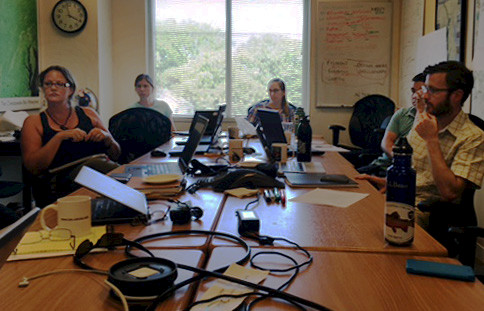Lessons on how to synthesize science
Bill Dennison ·We recently completed our third SAV SYN workshop, which is an effort to synthesize (SYN) data related to the submerged aquatic vegetation (SAV) of Chesapeake Bay. We have been analyzing a variety of data sets to better understand how SAV are responding to changes in the Bay and to understand what we can infer about the progress of Bay restoration activities. This effort is proving to be a productive collaboration among 15 scientists from 5 different institutions. This blog is focused on which elements of this collaboration can serve as models for future science integration projects.

There are six specific elements of the SAV SYN effort which can serve as synthesis models: 1) experienced leadership, 2) limited size, 3) multiple immersive workshops, 4) regular communication, 5) flexibility and 6) product focus. Each of these elements can be emulated as follows:
- Experienced leadership. Bob Orth and I are relying on our collective experience to lead this effort. The most important thing we did was to carefully choose a team of experienced and young scientists to participate. We have enlisted a cadre of bright young scientists, in particular, Jon Lefcheck, who bring a suite of new tools for data analysis and interpretation. We also set the agenda and goals for the workshops, organize the logistics and liaise with the Chesapeake Bay Program leadership.
- Limited size. One of the important lessons from the National Center for Ecological Analysis and Synthesis and the National Socio-Environmental Synthesis Center is that the group size needs to be limited. A dozen scientists (plus or minus) is a good size to get things accomplished. The typical Chesapeake Bay Program Science and Technical Advisory Committee workshop size is thirty to forty scientists, which caters to the large numbers of scientists involved in the Bay Program activities and is good for information dissemination, but does not promote productive synthesis efforts.
- Multiple immersive workshops. We are running a series of multi-day immersive workshops to generate conceptual models, review data and discuss analysis approaches. We share meals throughout the process which allows conversations to continue beyond the workshops. We share stories and get to know one another on a personal level, allowing us to celebrate successes of participants (e.g., job offers, papers accepted). And one of us (me) generates topical poetry for the occasion.
- Regular communication. The immersive workshops are separated by several months, but Bob Orth insures good communication with regular email updates and phone calls. In addition, workshop participants stay in close contact when working on a data analysis issue or finalizing a manuscript.
- Flexibility. We intentionally do not schedule every minute of the workshops, not just to avoid 'death by Powerpoint', but also to insure that we can adapt to progress on the various components. We create opportunities for break out sessions on specific topics, and we allow individuals to wander off to deal with personal business or to answer emails as they need to. We also are flexible on the composition of the group, making adjustments for changes in job status and for inclusion of key researchers.
- Product focus. The collaborative process is facilitated by the co-production of collaborative products. We scope out the peer review papers together during the workshops and then assign ourselves tasks to analyze and interpret data and then write the papers. In addition, we design a series of science communication products in which we enlist the assistance of Chesapeake Bay Program and Rich Batiuk did an excellent job for SAV SYN), but they also need to be willing to let the scientists approach the analysis in their own way (Rich allowed us this freedom). This freedom unleashes the creativity and energy of the scientists. Third, a nominal amount of support for the Chesapeake Bay Program is needed for this effort to reimburse travel expenses and cover the salary of one postdoctoral scholar (Jon Lefcheck). The workshop facilities and logistical support have been provided by the University of Maryland Center for Environmental Science (UMCES). But the amount of leveraged funding that this generates is prodigious. The largest contribution that dwarfs anything that the Chesapeake Bay Program or UMCES provides is the in kind contributions of the participating scientists. The participating scientists, and their respective institutions or agencies, are contributing greatly to the overall intellectual capital for Chesapeake Bay. They are donating their creative energies fully to the synthesis effort, and they receive the scientific peer acknowledgement through the papers which result from the synthesis effort.

Workshop participant having dinner in Annapolis It is our desire that the SAV SYN effort will result in high quality contributions to the scientific literature, and generate meaningful and timely management recommendations based on scientific knowledge. But the 'secret agenda' is that we aspire to provide an improved model for scientific input to the Chesapeake Bay Program. So, we are tracking the process of this synthesis effort by this and future blog posts.



About the author
Bill Dennison

Dr. Bill Dennison is a Professor of Marine Science and Vice President for Science Application at the University of Maryland Center for Environmental Science.

